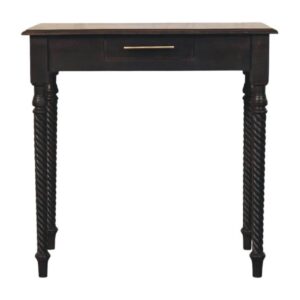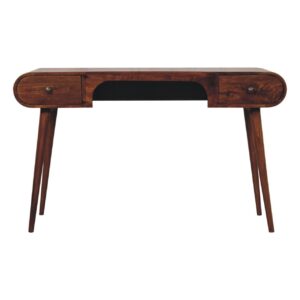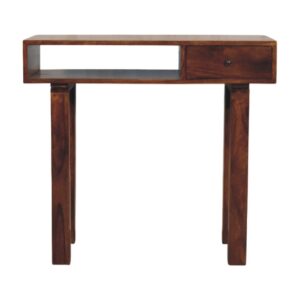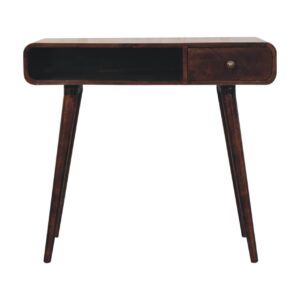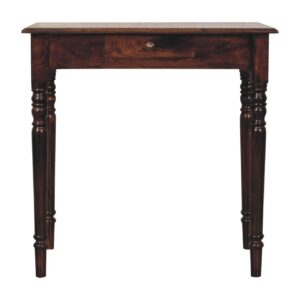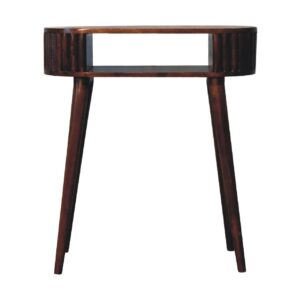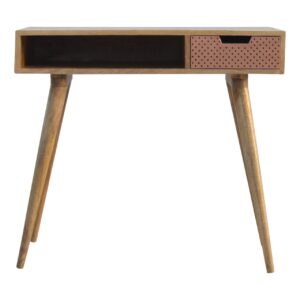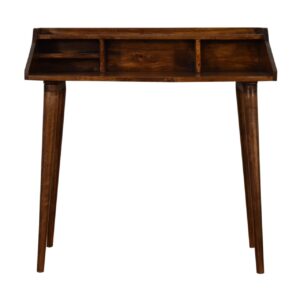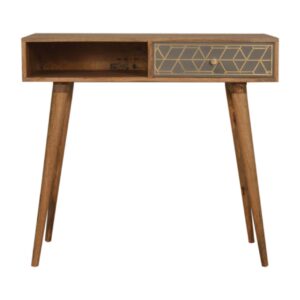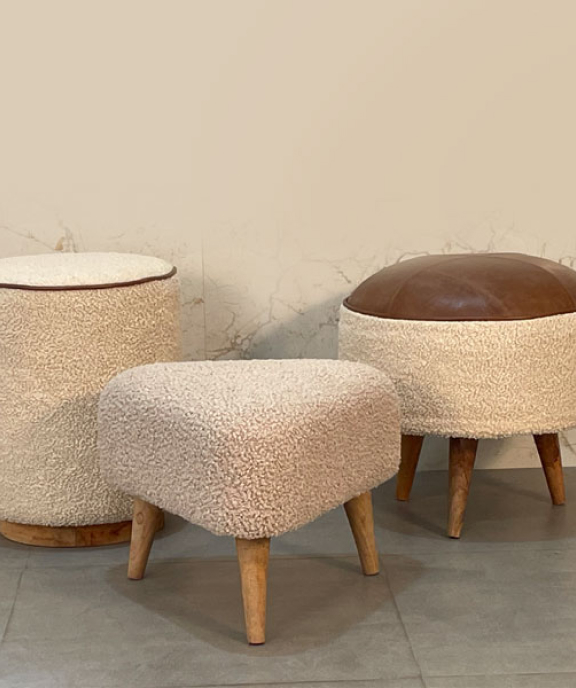A writing desk is a specific type of furniture tailored for writing tasks, featuring a flat surface and built-in storage that aids productivity. These desks have a long history, evolving from ancient writing surfaces to modern designs that cater to various needs. They come in many styles, including traditional, modern, and minimalist options, and often incorporate ergonomic features for comfort. Materials range from wood to metal, influencing aesthetics and durability. Choosing the right writing desk can enhance your creative potential by providing a designated workspace. Understanding the different options will allow you to make an informed decision for your writing needs.
Definition of a Writing Desk
A writing desk is a specific type of furniture designed primarily for writing and often features a flat surface and storage compartments. Typically, these desks are crafted from various materials, such as wood, metal, or glass, and may include drawers or shelves for organizing supplies. The design aims to promote comfort and efficiency, providing enough space for writing instruments, paper, and other resources. You’ll find that some writing desks incorporate ergonomic elements, enhancing posture while you work. They come in different styles, from traditional to modern, allowing you to choose one that fits your aesthetic. Ultimately, a writing desk serves as a dedicated workspace, fostering productivity and focus in your writing endeavors.
Historical Evolution of Writing Desks
Writing desks have evolved considerably from ancient writing surfaces, reflecting changes in both materials and societal needs. As you explore the various design transformations over time, you’ll notice how each era’s artistic influences and technological advancements shaped the functionality and aesthetic of these essential pieces of furniture. Understanding this evolution not only highlights the practical aspects of writing desks but also reveals their cultural significance throughout history.
Ancient Writing Surfaces
Throughout history, various ancient societies developed unique surfaces for writing that laid the groundwork for modern writing desks. In Mesopotamia, for instance, scribes used clay tablets, impressing characters with styluses, while ancient Egyptians wrote on papyrus, a material made from the papyrus plant. In China, bamboo strips served as an early writing surface, providing flexibility and portability. The Greeks and Romans utilized wax tablets, allowing for easy corrections by smoothing the surface. These surfaces reflect the evolving needs of communication and record-keeping. Each civilization adapted materials based on availability and practicality, influencing how writing was conducted. These ancient innovations set the stage for more sophisticated writing desks, integrating both function and form in the centuries to follow.
Design Transformations Over Time
As societies evolved, so did the design of writing desks, adapting to the changing needs of users. In ancient times, desks were simple surfaces for writing, often made from wood or stone. During the Renaissance, intricate carvings and compartments emerged, reflecting the era’s artistic values. The Industrial Revolution introduced mass production, making desks more accessible and functional, with designs focusing on efficiency. The 20th century saw the rise of minimalism, where sleek, modern lines replaced ornate features. Today, you’ll find writing desks designed for various purposes, such as home offices or student workspaces, incorporating technology-friendly elements. This ongoing evolution illustrates how writing desks remain relevant, continually accommodating advancements in lifestyle, work habits, and personal preferences.
Types of Writing Desks
Now that we’ve explored the historical evolution of writing desks, it’s crucial to look at the different types available today. You can choose from traditional writing desks that exude classic charm, modern minimalist desks that emphasize simplicity and functionality, or corner writing desks that maximize space efficiency. Each type serves a specific purpose and can greatly influence your writing experience, so let’s examine them in detail.
Traditional Writing Desks
When you think of traditional writing desks, several distinct types come to mind, each with its own unique charm and functionality. The roll-top desk, for instance, features a retractable top that conceals writing materials, offering privacy and organization. The secretary desk combines a writing surface with multiple compartments for storage, making it ideal for smaller spaces. The partners desk, designed for two users, boasts a large surface area and often includes drawers on both sides. Another classic is the Davenport desk, which has a slanted writing surface and built-in storage. These desks, with their craftsmanship and historical significance, not only serve practical purposes but also add a touch of elegance to any workspace.
Modern Minimalist Desks
While traditional writing desks often emphasize ornate designs and historical features, modern minimalist desks focus on clean lines and functionality. These desks are designed to be sleek and unobtrusive, making them ideal for contemporary spaces. You’ll notice that they typically use materials like metal, glass, or light-colored wood, which enhances their airy aesthetic. The emphasis on simplicity allows for better organization, as many have built-in storage solutions that keep your workspace clutter-free. Additionally, modern minimalist desks prioritize ergonomics, often featuring adjustable heights for comfort during long working hours. By choosing a minimalist desk, you embrace a design philosophy that values efficiency and clarity, providing a conducive environment for productivity without unnecessary distractions.
Corner Writing Desks
Corner writing desks are a smart solution for maximizing space in smaller rooms or home offices. By utilizing the often-overlooked corner area, these desks provide a compact workspace that fits snugly into tight spots. They typically feature an L-shaped design, allowing you to position your computer, books, and supplies efficiently. This design not only enhances organization but also promotes a more focused working environment. Many corner desks come with added storage options, like shelves or drawers, which further optimize your workspace. When choosing a corner writing desk, consider materials, size, and style to guarantee it complements your room’s aesthetic. Ultimately, corner writing desks combine functionality with style, making them a practical choice for anyone looking to create an efficient workspace.
Design Features and Materials
A writing desk often combines functionality with aesthetic appeal, making it a central piece in any workspace. These desks typically feature a flat surface for writing, along with compartments or drawers for storage, enhancing organization. Materials vary widely; solid wood offers durability and timeless style, while metal frames provide a modern touch. Some desks use engineered wood or laminate, which can be more affordable and come in various finishes. Design elements, such as built-in cable management, ergonomic height, and adjustable features, cater to user comfort and efficiency. A desk’s visual appeal is also important, with options ranging from minimalist designs to ornate styles, allowing you to choose one that complements your overall decor while meeting your functional needs.
Importance for Creativity and Productivity
Creating a dedicated workspace with a writing desk can greatly boost your creativity and productivity. A well-designed writing desk provides an organized area where you can focus solely on your tasks, minimizing distractions. By having a specific place for your materials, you streamline your workflow, allowing ideas to flow more freely. Additionally, the act of sitting at your desk signals to your brain that it’s time to work, enhancing your concentration. The physical separation between work and leisure spaces can also improve your mental clarity, enabling deeper thinking and creativity. Moreover, a writing desk often encourages better posture and comfort, which are essential for prolonged writing sessions. Ultimately, investing in a writing desk is an investment in your creative and productive potential.
Tips for Choosing a Writing Desk
Choosing the right writing desk can greatly impact your workspace experience. First, consider the size; it should fit your space without overwhelming the room. Next, think about the height; an adjustable desk can accommodate different preferences and promote comfort. Material matters too; solid wood offers durability, while metal or laminate may provide a modern look. Assess storage options like drawers or shelves, as they can help keep your workspace organized. Additionally, evaluate the desk’s style—pick one that reflects your personality and aligns with your office decor. Finally, don’t forget to test it out; sit down and imagine working there, ensuring it meets your functional and aesthetic needs. Making these considerations will help you choose wisely.



